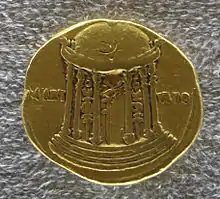Temple of Mars Ultor
The Temple of Mars Ultor was an octastyle sanctuary created with the Corinthian order in Ancient Rome. The construction has been completed in 2 BC but the project of Augustus stems from the victory obtained by the battle of Philippi in 42 BC. It was dedicated to the god Mars to avenge the assassination of Julius Cesar.[1] It was founded by Emperor Augustus in the Forum of Augustus.[2] If still in use by the 4th-century, the temple would have been closed during the persecution of pagans in the late Roman Empire, when the Christian Emperors issued edicts prohibiting non-Christian worship.


This Temple defines, with all other architectural elements and decorations, the authority of the new ideology of the rising Augustan empire. In fact for Augustus was essential exalting the values of the religion in a new order where ancestors and the past of Rome (mythology) were the principal ways to restore order that over of 50 years of civil wars had destroyed.
Ultor means "avenger" and it refers to the battle of Philippi in which Marcus Antonius, Octavian, and Marcus Aemilius Lepidus defeated the two main conspirators of Gaius Julius Caesar: Brutus and Cassius.
The pediment is the symbolic representation of the austerity that gods have on all of Romans vicissitudes, in particular in the military (thanks to the presence of Mars in the sanctuary). Starting from the left side there are: the personification of the Palatine mount, Romulus in the guise of augurae, Venus, Mars, the goddess Fortuna, the goddess Roma in arms and the representation of Tevere river.
All of these figures recall the war and the justice that Ottaviano obtained in the name of his adoptive father (Gaius Julius Caesar) . But Augustus, thanks to the implicit figurative language of his propaganda, reclaimed, at the same time, his triple victory in Illyria, in Actium and in Egypt through the figure of the goddess Fortuna.
See also
References
- Lucrezia Ungaro, "Foro di Augusto", in I luoghi del consenso imperiale. Foro di Augusto. Foro di Traiano. Introduzione storico topografica (catalogo mostra), Roma 1995
- John W. Stamper (16 February 2005). The Architecture of Roman Temples: The Republic to the Middle Empire. Cambridge University Press. pp. 132–. ISBN 978-0-521-81068-5.